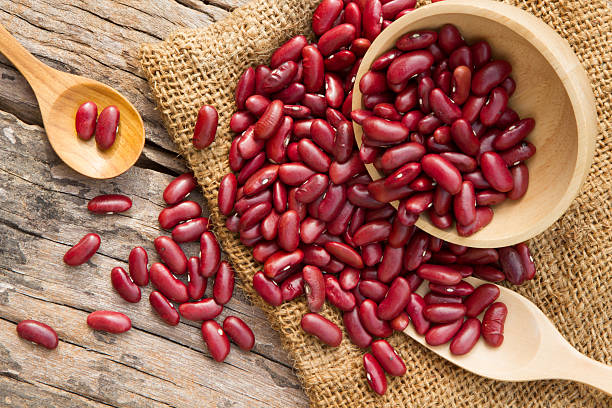Rajma, or kidney bean, is a must-have legume that may be found in a variety of traditional Indian and international recipes. It gets its name from its look and similarity to kidney colour.
These healthy legumes come from the herbaceous plant Phaseolus vulgaris, which is technically known as Phaseolus vulgaris. Although these beans are native to Mexico and Central America, they are widely farmed across the world, especially in India. While red beans are used in the traditional North Indian rajma stew, these pods are also available in white, cream, black, purple, and spotted varieties.
Nutrition Facts:
These beans are high in protein and can be used in place of red meat. In fact, steaming hot rajma chawal provides a great mix of protein that is comparable to dairy or animal protein without the extra calories and saturated fat. The protein content of a cup of kidney beans is 15 grammes.
Kidney beans are high in minerals including copper, iron, manganese, phosphorus, and molybdenum, as well as vitamins B1 and folate. These nutritious beans are a perfect complement to a diabetic diet since they have no added sugar, are naturally high in dietary fibres, and have a low glycemic index (GI).
Kidney beans, which are high in starchy carbs, B vitamins, and roughage, aid digestion and promote optimum metabolism. Furthermore, these legumes are high in isoflavone and flavonoid antioxidants, which assist in blood sugar regulation, minimising blood pressure increases, and maintaining cardiac muscle function and heart health.
As a result, the high nutritional content of kidney beans gives a slew of health advantages, including blood sugar regulation, cholesterol reduction, and immune enhancement.
Rajam is endowed with a plethora of bioactive substances, including the following:
Isoflavones: The richness of isoflavones in kidney beans acts as potent phytoestrogens that alleviate hot flashes, regulate the menstrual cycle, prevents osteoporosis and lowers the risk of breast cancer.
Anthocyanins: Kidney beans get a deep red hue due to the abundance of anthocyanin pelargonidin that play a key role in averting the risk of heart disease.
Antinutrients In Kidney Beans
Antinutrients are substances that diminish nutritional value and hinder nutrient absorption from the gut in raw and inadequately cooked kidney beans. The following are some of the antinutrients found in kidney beans:
Iron and zinc absorption is hampered by phytic acid.
Protease inhibitors, commonly known as trypsin inhibitors, prevent digestive enzymes from working properly.
Starch blockers prevent carbs from being absorbed from the gastrointestinal system.
When kidney beans are soaked and cooked thoroughly, the antinutrient actions are rendered inactive entirely or partially.
Health Benefits:
Regulates Blood Sugar
Rajma is a good source of soluble fibre and has a low glycemic index, making it a great legume for controlling blood glucose levels. Kidney beans are a type of slow-burning carbohydrate that might help you avoid a blood sugar surge. Furthermore, the soluble fibres in rajma help manage diabetic symptoms by lowering blood sugar and cholesterol levels, improving insulin sensitivity, and lowering blood sugar and cholesterol levels.
Heart Healthy
The high fibre content of rajma helps to minimise the risk of heart disease. Soluble fibre in rajma decreases bad cholesterol (LDL) and raises good cholesterol (HDL) by producing a gel-like material in the stomach and preventing cholesterol reabsorption into the body, according to research. Rajma is also high in potassium, which helps to widen blood vessels and reduce blood pressure.
Prevents Cancer
The high fibre content of rajma helps to minimise the risk of heart disease. Soluble fibre in rajma decreases bad cholesterol (LDL) and raises good cholesterol (HDL) by producing a gel-like material in the stomach and preventing cholesterol reabsorption into the body, according to research. Rajma is also high in potassium, which helps to widen blood vessels and reduce blood pressure.
Sustains Weight Loss
The abundance of soluble fibre and protein in rajma is one of the best legumes to be added in a weight loss meal plan. These beans keep you satiated, slow gastric emptying time, and helps in losing weight. The presence of alpha-amylase inhibitor in rajma hinders the absorption and breakdown of starch and aids in losing weight.
Strengthens Bones
Rajma is high in calcium and magnesium, two vital elements that assist to build bones and prevent osteoporosis. Rajma’s high folate content promotes joint health and reduces the risk of bone diseases such as osteomalacia and osteoporosis.
Side Effects
Raw or partly cooked kidney beans are poisonous because they contain significant levels of phytohaemagglutinin, a toxic protein that can induce diarrhoea and vomiting. Excessive consumption of cooked kidney beans might induce digestive problems including bloating and gas.
Kidney beans should be soaked for at least 5 hours and carefully boiled to remove the majority of the poison, making them safe, nontoxic, and healthy to eat.





